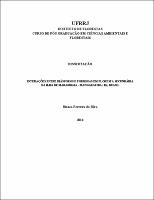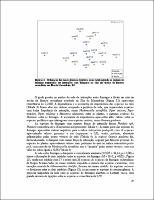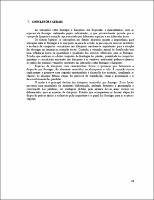Please use this identifier to cite or link to this item:
https://rima.ufrrj.br/jspui/handle/20.500.14407/11381| Tipo do documento: | Dissertação |
| Title: | Interações entre diásporos e formigas em floresta secundária na Ilha da Marambaia - Mangaratiba / RJ, Brasil |
| Other Titles: | Interactions between diaspores and ants at secondary forest in Ilha da Marambaia - Mangaratiba / RJ, Brasil |
| Authors: | Silva, Bianca Ferreira da |
| Orientador(a): | Freitas, André Felippe Nunes de |
| Primeiro membro da banca: | Mello, Marco Aurélio Ribeiro |
| Segundo membro da banca: | Queiroz, Jarbas Marçal de |
| Keywords: | interação formiga-fruto;remoção de sementes;dispersão secundária;Mata Atlântica;ant-fruit interaction;seeds remotion;secondary dispersion;rainforest |
| Área(s) do CNPq: | Recursos Florestais e Engenharia Florestal |
| Idioma: | por |
| Issue Date: | 21-Feb-2014 |
| Publisher: | Universidade Federal Rural do Rio de Janeiro |
| Sigla da instituição: | UFRRJ |
| Departamento: | Instituto de Florestas |
| Programa: | Programa de Pós-Graduação em Ciências Ambientais e Florestais |
| Citation: | SILVA, Bianca Ferreira da. Interações entre diásporos e formigas em floresta secundária na Ilha da Marambaia - Mangaratiba / RJ, Brasil. 2014. 72 f. Dissertação (Programa de Pós-Graduação em Ciências Ambientais e Florestais) - Universidade Federal Rural do Rio de Janeiro, Seropédica. |
| Abstract: | Entre os diversos táxons que interagem entre si, formigas e angiospermas possuem uma longa história evolutiva conjunta, iniciada desde o período Cretáceo, e que atualmente incluem desde relações antagonistas até relações mutualistas. Interações entre formigas e diásporos resultam em diversos benefícios para as plantas, como a dispersão de suas sementes. Nosso objetivo foi identificar quais as espécies de formigas interagem com as espécies de diásporos existentes em um trecho de floresta secundária, na Ilha da Marambaia, RJ. Além de identificar os participantes da rede de interações, procuramos determinar a influência de fatores, como a quantidade de recursos disponíveis na área de estudo e as variáveis climáticas sobre o total de interações (capítulo 1). Selecionamos quatro espécies de diásporos com o objetivo de determinar quantos são removidos, o sítio final de deposição e a distância de remoção desses diásporos (capítulo 2). Registramos 675 interações entre 43 espécies de formigas e 22 espécies de plantas. As espécies Pheidole sp4, Pheidole radoszkowskii e Wasmannia auropunctata foram mais comuns nas interações. Entre as plantas, Guarea guidonia e Miconia prasina recebem a maior quantidade de interações. As variáveis abióticas, como luz e temperatura, não alteram o número de interações. A disponibilidade de recursos no ambiente também não influencia, mas a riqueza de diásporos disponibilizados leva a maiores quantidades de registros de interações. As espécies de plantas possuem, em sua maioria, taxas consideráveis de remoção após cair no solo. Contudo, as distâncias carregadas por formigas foram pequenas, alcançando no máximo quatro metros e o destino final de deposição dos diásporos foram os ninhos, geralmente. As formigas exercem um papel importante na etapa de reprodução das plantas. A rápida remoção dos diásporos ou a limpeza deles diminui as chances de ataque por patógenos, favorecendo à germinação. Mesmo as pequenas distâncias removidas por formigas são suficientes para retirar os diásporos de zonas de grande predação e alta competição. A deposição dos frutos nos ninhos pode ser determinada como dispersão direta, já que algumas espécies germinam em áreas mais próximas a ninhos do que em áreas adjacentes, sem ninhos. As áreas de ninhos possuem características diferenciadas como a penetrabilidade do solo e quantidade de nutrientes disponíveis no solo, favorecendo o crescimento de plântulas nessas áreas. As formigas são, desta forma, possíveis agentes de um processo de dispersão e a sua grande abundância nos solos das florestas pode levar a acreditar na força que essas espécies exercem sobre as espécies de diásporos em ambientes florestais. |
| Abstract: | Among the various taxa interacting, ants and angiosperms have a long evolutionary history together, starting from the Cretaceous period, which currently range from antagonistic to mutualistic relationships. Interactions between ants and diaspores (plant disperser unit) result in many benefits for the plants, and the dispersal of its seeds. Our goal was to identify which species of ants interact with the species of diaspores in secondary forest on Ilha da Marambaia, RJ . In addition to identifying the participants of the network of interactions, we sought to determine the influence of factors such as the amount of available resources in the study area and climatic variables on total interactions (Chapter 1). We selected four species of diaspores in order to determine how many are removed, the final site of deposition and removal distance of these diaspores (Chapter 2). We recorded 675 interactions between 43 ant species and 22 plant species. Pheidole sp4, Pheidole radoszkowskii and Wasmannia auropunctata were more common species in interactions. Among the plants, Guarea guidonia and Miconia prasina receive the greatest amount of interaction. The abiotic variables, such as light and temperature, do not change the number of interactions. The availability of resources in the environment does not influence, but the wealth of available propagules leads to larger amounts of records of interactions. The species show, mostly, considerable removal rates after falling on the ground. However, the distances carried by ants were short, reaching a maximum of four meters and the final destination of deposition of diaspores were the nests, usually. Ants play an important role in plant breeding stage. Rapid removal of the seeds or cleaning them reduces the chances of attack by pathogens, favoring germination. Even shortremoved distances by ants are sufficient to deprive the diaspores of large areas of high predation and competition. The deposition of the fruits in the nests can be determined as a direct scattering, since some species germinate more near nests than in adjacent areas without them. The nesting areas have different characteristics, such as soil penetrability and amount of available nutrients in soil, favoring the growth of seedlings in these areas. Ants are thus possible agents of a dispersion process and its abundance in forest soils may lead to believe in the strength that these species have on the species of diaspores in forest environments. |
| URI: | https://rima.ufrrj.br/jspui/handle/20.500.14407/11381 |
| Appears in Collections: | Mestrado em Ciências Ambientais e Florestais |
Se for cadastrado no RIMA, poderá receber informações por email.
Se ainda não tem uma conta, cadastre-se aqui!
Files in This Item:
| File | Description | Size | Format | |
|---|---|---|---|---|
| 2014 - Bianca Ferreira da Silva_1.pdf | 2014 - Bianca Ferreira da Silva_1 | 2.86 MB | Adobe PDF |  View/Open |
| 2014 - Bianca Ferreira da Silva 2.pdf | 2014 - Bianca Ferreira da Silva 2.pdf | 3.45 MB | Adobe PDF |  View/Open |
| 2014 - Bianca Ferreira da Silva 3.pdf | 2014 - Bianca Ferreira da Silva 3.pdf | 4.46 MB | Adobe PDF |  View/Open |
Items in DSpace are protected by copyright, with all rights reserved, unless otherwise indicated.

